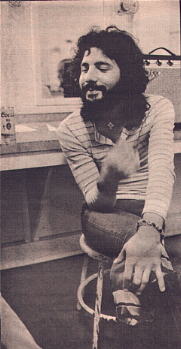- Rolling Stone
- May 9, 1974
- By Paul Gambaccini
- Photo: Annie Leibovitz
-
-
- Cat Stevens’ Return:

- Pop Goes the Poof
LONDON Two children,
one black and one white, played on the doorstep of Cat Stevens’s terraced house.
"Are you here for the interview?" asked one. ‘He’s in there,"
pointed the other, as professionally as a tour guide, even though the occasion was a rare
one.
Stevens was
entertaining a group of reporters on the eve of a tour that would take him to the U.S. for
24 dates, beginning April 22nd in Detroit and ending May 20th in Los Angeles. He would
conclude the tour with concerts in Australia and Japan. And he had just released a new
album, Buddha and the Chocolate Box, and the initial impression was that Cat was
back to his pre-Foreigner ways, with shorter, poppier tunes, sweets but no
18-minute suites.
Stevens eased himself into
a cross-legged position on the floor of his living room and explained the title of the new
album: He was on a plane to Florida a year ago, he said, and he was carrying a small
porcelain Buddha figure and a box of chocolates with him.
"I suddenly realized
that was all I had. Whether I died or not, it would just be the ‘Buddha and the
chocolate box. I was trying to find the significance in that when I realized that was the
significance. That’s all that had to be known."
Cat dispensed more
philosophical bonbons: "One cannot discount any moment in one’s life. There is
no moment that is not important. Just like the boy on the back of the album finds
enlightenment from a chocolate box [in a cartoon strip conceived and drawn by Stevens. You
can find it from anything. It’s like meditation, you can look at a piece of paper and
find anything you want in the piece of paper."
Cat’s cloudy ways of
expression follow him onto the stage. At the Theatre Royal in London in late March, he
castigated himself for moving across the stage with "the walk of a poof. I’m
just a poof. Well, maybe not. What’s the opposite of poof? Heterosexual? Well, then,
I guess I’m just a ‘heto.’ Well, I don’t really know."
Shortly after that
interlude, Stevens told the house that Foreigner hadn’t sold too well, but
that didn’t mean much, since chart positions weren’t important to him. Then he
went on to exclaim: "The new one went in at number 16!" However puffy, Stevens
seemed sincere at his home, trying to explain his albums, the ambitious Foreigner and
the new one, on which he’s reunited with producer Paul Samwell-Smith.
"Paul and I were
getting too familiar before Foreigner," said Cat. "Being away got us
excited about going into the studio again." Samwe1l~-Smith had teamed with Stevens to
produce Tea for the Tillerman and Teaser and the Firecat.
"Foreigner was
like going away for a while," said Stevens. "People want to hear from you.
I’m not going too far, I never want to be out of reach, I want to be here for anybody
who wants to relate to me. So after Foreigner I wanted to say, ~ ‘I’m
still here, you don’t have to worry d about it."’
The single from Foreigner.
"The Hurt," failed to make the British charts and barely reached the Top 20
in America. "I’ve always been a bad picker of singles," said Cat. He chose
the new single, too, he said, "but I got a lot of I other people to give reactions
because I love it so much." It’s called "Oh Very Young."
"I’ve seen youth
lost," Stevens reasoned. "I’ve watched myself grow, and seen my attitude to
children change. One must always change, that’s what children I do. I find a lot of
people take their kids for granted, even people who were in the hippie thing. I
haven’t broken the line yet. I still enjoy the kids on the street, and there’s a
school across the back that I’m looking forward to visiting."
Stevens drew puzzled stares
from several of the reporters at his house when he began drawing a connection between
Buddha and Jesus Christ, who both rate a verse in the song, "Jesus."
"I see no difference
in what they were doing," he said. "Jesus died, really. .not violently, but on a
cross which became the symbol of Jesus . . . whereas Buddha didn’t even die as we
know.
"They were both saying
exactly the same thing, which is why I think of them both."
As if to match the
spiritual mood of Cat Stevens, the stage design for the American portion of his tour is
all in white. A white nylon band shell was built in Los Angeles. Described by one crew
member as "kind of floating, like half a flower," it will serve as background
for two grand pianos white, of course and an expected company of ten musicians and singers
behind Stevens.
It appeared from his London
performances, however, that Stevens was not yet comfortable onstage. After a generally
uninspired performance, he said goodnight to the opening-night capacity crowd at the
Theatre Royal: "Well, that’s all for another year." He told the audience
they had been "nice, but cool - but then, I was cool, wasn’t I?" |